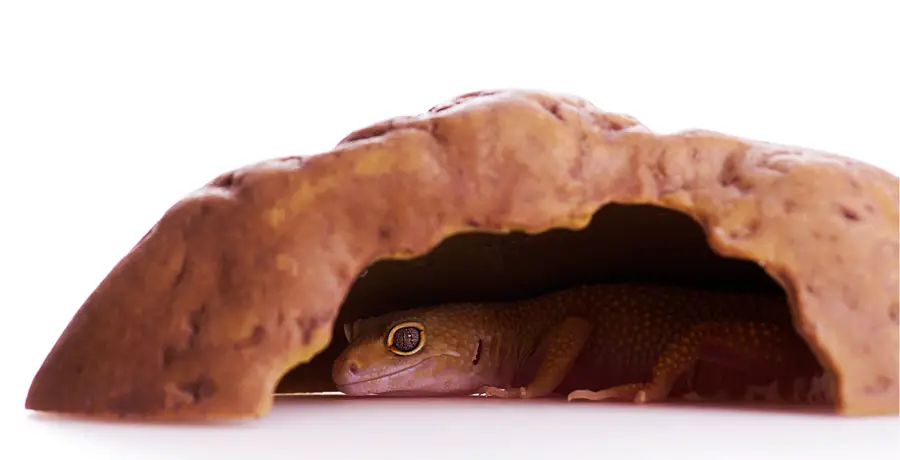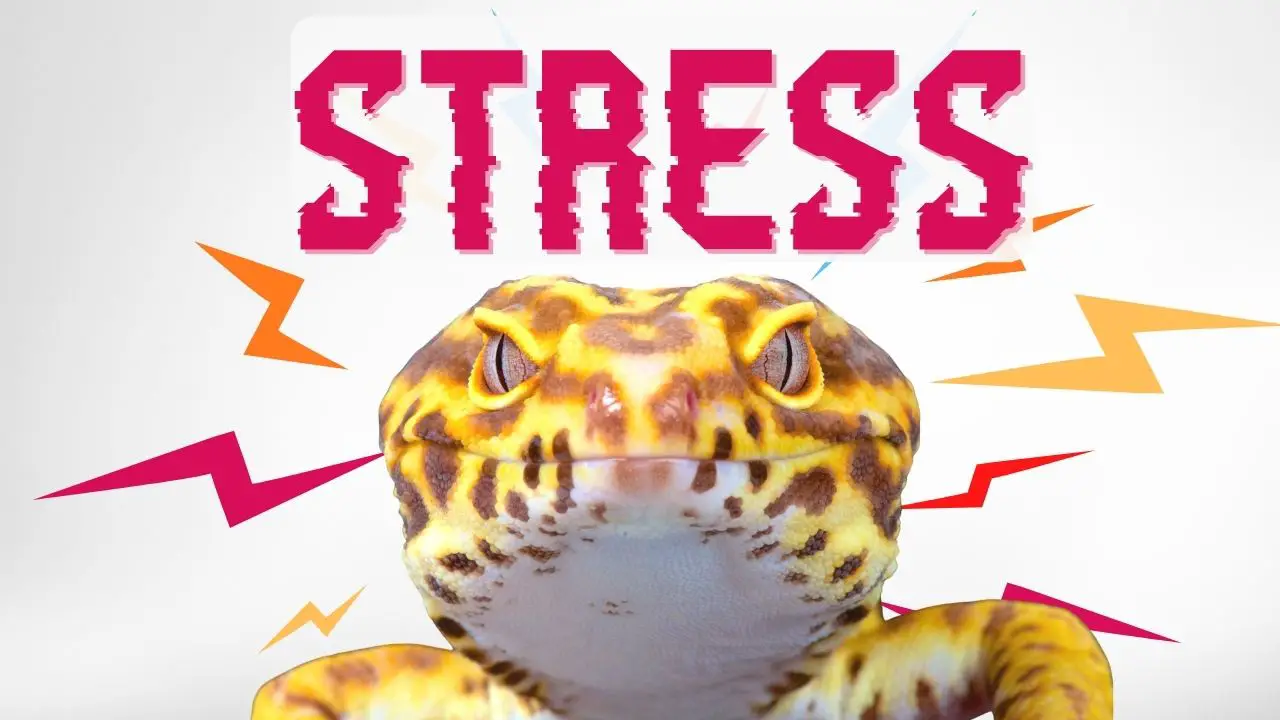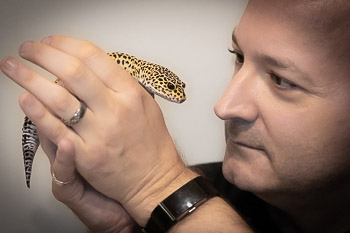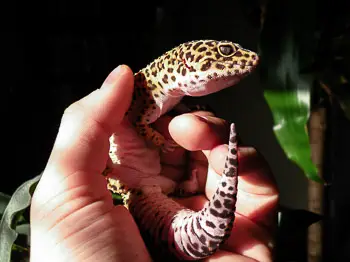When things aren’t going well, we can feel stressed, and so can our pets. As pet owners, we want to make sure our animals are well cared for and stress free. Noticing signs of stress is the first step towards providing a better environment. How can you tell if your leopard gecko is stressed?
Common signs of stress in leopard geckos are: decreased appetite, weight loss, excessive hiding, glass swimming, and tail waving. Improper setup and poor handling are the root cause of most stress factors.
Let’s discuss how signs of stress, the causes of stress, and how to avoid stress in leopard geckos.
Leopard Gecko Stress Signs
Loss of Appetite
Decreased or lack of appetite is one of the number one signs of stress in leopard geckos. Aside from offering the wrong food items, a decreased appetite is usually a result of other health issues and should be closely monitored.
Related post: Check out our feeding guide to find out what, how, and when, your gecko should be eating.
Weight Loss
If your gecko has a decreased appetite, it’s only natural that weight loss will follow. The good news is leopard geckos can live off of the fat reserves in their tails. This is a survival function that keeps them nourished when food sources are scarce, or during brumation. The fat store will only last so long, and the tail will become noticeably thinner as it does.
If your gecko has a sudden drop in weight or it’s tail is thin, it may be time to consult a qualified veterinarian.
Excessive Hiding
If your gecko is spending extended periods in a hide, it may be cause for concern. If it is not coming out, it does not feel comfortable in its environment. There could be numerous factors to consider here. It could feel threatened, it’s hiding place could be the only area in the enclosure with a comfortable temperature, it may be hiding to avoid bright lights, or be experiencing a medical issue.
First, make sure you have more than one hide in the enclosure, and that these are in different temperature zones. We’ll discuss why a temperature gradient is important below.
Also, keep in mind that it takes time for your pet to acclimate to new environments or changes. Check out our post on helping your leopard gecko settle in if you’re just bringing it home.
Glass Swimming
You may notice from time to time your leopard gecko “glass swimming,” or “glass surfing,” or “glass dancing,” where it may lean its belly against the glass wall of the enclosure and flair its front legs.
This could be simply a sign of it exploring its habitat and boundaries, or it could have more dire motivation. If the conditions in the enclosure are undesirable, your gecko could be doing its best to escape, and simply cannot climb the glass.
If there is not enough food, it could be trying to get to a different place where it can try its luck hunting. If it is crowded or bullied by tank mates, it may be trying to find safety or shelter. If the environment does not have optimum temperatures, your gecko may be too hot or too cold and trying to get somewhere it can regulate its body heat.
Glass surfing can be cute, but make sure you re-evaluate your pet’s environment and conditions before dismissing the behavior.
Tail Waving
Tail waving is one of the leopard gecko’s common behaviors, and is usually done as a warning. The leopard gecko is trying to make itself look bigger.
The movement of the tail is also a focal point for predators when a gecko feels threatened, as predators will most likely strike at the moving tail. Leopard geckos can voluntarily tail drop when feeling lots of stress, and escape to safety. Doing so may cause long term stress as the gecko recovers from its tail wound. This is a vulnerable time for a gecko; it’s not only missing a major body part, it is also lacking its backup food supply. Though it will grow back, the tail stump is never as long or strait as the original tail.
For more about tail dropping and behavior, check out our post about leopard gecko tails.
Health Issues
Stress and poor health go hand in hand, one usually leading to the other. Issues like impaction, respiratory infection, metabolic bone disease, stick tail, tail drop, etc. are all cause for concern and should be addressed.
Please check out our posts on how to tell if your gecko is sick or dying. More importantly, you may want to consult with a veterinarian that specializes in reptiles or exotics if you have concerns.
What Causes Stress in Leopard Geckos?
Now that we’re familiar with the signs of stress, let’s take a look at some likely causes:
New Environment or Enclosure
It’s natural for any animal (and people) to feel stress during a major change like moving into a new home. It may take time for your pet to adjust when you first bring it home or move it to a new gecko enclosure.
You can check out our tips on getting your gecko to settle in to help out here, or make sure you have the essentials covered in your tanks setup.
Wrong Tank Size
A 10 gallon tank is a good size for a juvenile gecko, and provides enough space for a few good hiding spots and natural movement. As the animal grows, so should its available space.
For a single healthy adult gecko, a 20 gallon tank is a good size. Bonus points for opting for the 20 gallon long or 20L size. These tanks are longer than they are tall to provide more floor space and less height, as leopard geckos are not avid climbers and won’t have much use for the vertical space.
Incorrect Temperature
The ideal temperature for leopard geckos is between about 80 °F (27 °C) and 90 °F (32 °C). That said, the whole tank should not be the same temperature. There should be a warm side and cool side and a noticeable temperature gradient between the two. This way your cold blooded friend can decide where they feel most comfortable to self regulate their body temperature.
Also make sure you have the right type of heat. Under tanks heaters are best for leopard geckos, as they require the belly heat to properly digest their food. Placing an tank heating pad under the warm side of the tank is a great start.
Related Post: Best Leopard Gecko Heat Sources
Bright Lights, or Lack of Day and Night Cycle
Leopard geckos are crepuscular, meaning they are most active in the twilight hours around dusk and dawn. They typically sleep during the day, and don’t see much daylight in their natural habitat.
You should look to model a natural day and night cycle in your tank setup. This is easy to do with programmable light fixtures or smart outlets.
Also realize that your gecko may spend quite a bit of the day in its hide sleeping. Try to be mindful of its natural schedule and schedule feeding or plan handling time when it would naturally be awake. Most people would be stressed out if there were bright lights shining or people picking them up when they were tired and trying to sleep.
Competition for Food
Any animal (or person) will feel stress if their basic needs are not met, like having enough food. If leopard geckos are kept in the same enclosure, there will be competition for food. Larger or stronger geckos may prevent other tank mates from getting enough to eat.
Besides hunger, the confrontations themselves can cause stress, or lead to fighting or injury. You can read our post on keeping leopard geckos together to find out more.
Feeding Issues
Not enough food or poor diet are often reasons for stress. If your pet isn’t getting enough food, it will be constantly on the hunt looking for something that isn’t there. Its most basic need is not being met, and it may start to show signs of stress.
Similarly, if your gecko isn’t getting enough of the right kind of food, its nutrition and overall health will suffer. You need the right mix of live gut loaded feeder insects to give your gecko the diet it needs.
Lack of calcium is another dietary issue, especially in juvenile leopard geckos or females. Juveniles need calcium during early development to ensure their bones grow properly. If a female gecko is being bred, she will need additional calcium for egg production. You can find calcium supplements at most local pet shops, or you can compare prices online.
Competition for Shelter

Leopard geckos are generally solitary animals, and may suffer cohabitation stress if kept together once they reach about a year of age. They need their own space to hunker down and feel safe, and each lizard is going to need options in different temperatures.
If you’re housing multiple geckos together, make sure you have a larger tank and ample hides for each gecko.
Breeding issues
Female leopard geckos develop elevated stress levels as a result of breeding. First, there may be cohabitation stressed if the female is under constant pressure to mate, or subject to competition to food and shelter as a result of sharing her space.
Second, having babies is hard (just ask any mother!) Egg production saps the body of calcium, and females may need additional calcium to compensate and maintain a healthy diet.
Related Post: Read more about breeding leopard geckos and egg production.
Improper Handling
Improper or rough handling may cause your gecko to feel threatened, defensive, or take shelter. It’s important to be patient and gentle when handling your pet. You can read more in our post about leopard gecko handling tips.
Can Leopard Geckos Die from Stress?
The stress itself is unlikely to kill a leopard gecko, though the underlying conditions causing the stress can take their toll if not corrected, especially if these issues are health related. Keep in mind poor tank conditions or improper diet can not only be a source of stress, but may lead to health issues if not corrected.
Wrap Up – Leopard Gecko Stress and How to Avoid it
Leopard geckos are hardy animals, though prolonged stress can take its toll and compromise the health and longevity of your pet. By recognizing the signs of stress, you can look to find the source of stress and correct any issues early on.




